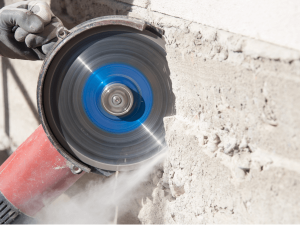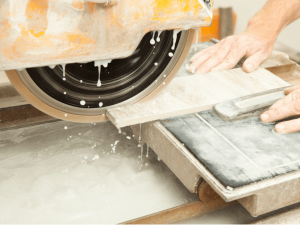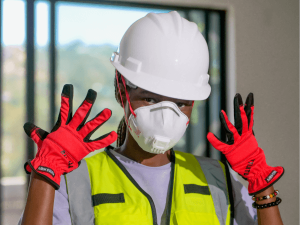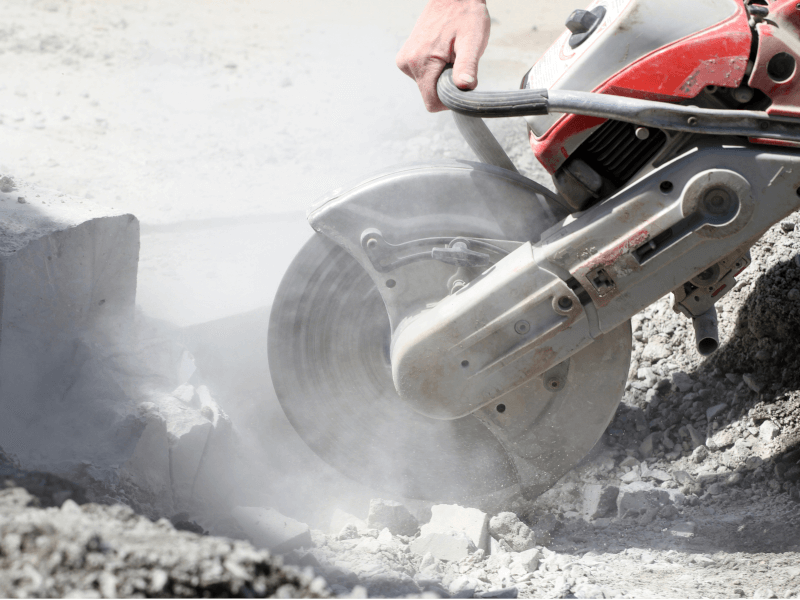Working with concrete can be a dirty job and trying to avoid dust is tricky. But there are methods to help cut concrete without dust.
To cut concrete without dust you should use a wet diamond saw. It dampens the concrete as you cut it and traps the dust in the water before it can become airborne. This dust then falls to the floor and can be removed with a floor scraper. Keeping the concrete wet is the key to reducing dust produced.
Let’s go through the best methods to properly cut concrete without dust.
How to prevent dust when cutting concrete
 To cut concrete safely without dust or mess, use a wet diamond blade. If the concrete is dry, dust will be produced as you cut through the material. A diamond blade is best for this task because they produce smoother cuts than most other saws. A wet diamond blade is the best tool for this type of work because the water will trap the concrete dust. By using water to catch dust, the particles fall down and turn into more of a sludgy substance. This prevents concrete dust from becoming airborne and those nearby from inhaling lots of it.
To cut concrete safely without dust or mess, use a wet diamond blade. If the concrete is dry, dust will be produced as you cut through the material. A diamond blade is best for this task because they produce smoother cuts than most other saws. A wet diamond blade is the best tool for this type of work because the water will trap the concrete dust. By using water to catch dust, the particles fall down and turn into more of a sludgy substance. This prevents concrete dust from becoming airborne and those nearby from inhaling lots of it.
The water from a wet cutting diamond blade also helps to cool and lubricate the blade while reducing dust. This stops the saw from overheating while being used.
If you choose to use a dry-cutting blade, like a multi-purpose diamond saw blade, be mindful that they can overheat regularly. You can use a dry-cutting blade with another water source to help prevent it from overheating and reduce dust.
One option for a water source is a portable pressurised water tank. This is usually a small bottle attached to two jets positioned on either side of a guard filled with water. A control valve attached to the bottles allows the operator to control the water supply. You should set your rate of water flow to half a litre per minute at a minimum. This type of addition is often a preferred solution because it is lightweight and portable. Some connect to taps via a hose which keeps the water flowing.
Choose a diamond blade size that is larger than the depth of your cut. A depth of 1/8-inch should be cut with a diamond blade that is at least 1/4-inch thick. It is also beneficial to have a concrete saw that has a dust collection system.
How to Use a Wet Diamond Blade for Cutting Concrete
To correctly cut concrete without dust using a wet diamond blade, you’ll need to apply water to the concrete before you begin cutting. You can use a hose or water sprayer to do this. The more water the better. If the concrete is dry, it will produce a lot of dust.
 You need to match the diamond blade to the material you intend to cut. Concrete with a lower PSI requires a blade with a hard bond. If the concrete has a higher PSI, you will need a blade with a softer bond to expose diamonds more regularly.
You need to match the diamond blade to the material you intend to cut. Concrete with a lower PSI requires a blade with a hard bond. If the concrete has a higher PSI, you will need a blade with a softer bond to expose diamonds more regularly.
Before you start, you need to prepare your work area. Remove any potential hazards and clean the workspace. Once this is done, use a straight edge and construction chalk to mark out the cutting area.
Check that your diamond saw blade has been serviced and is safe for use. Then turn on the water supply and let the concrete dampen.
Hold the saw at a 45-degree angle and lower it slowly and begin with small cuts. This will make it easier to get an even cut. Use the front handle to steer the blade along your outline. The best results are achieved by setting the machine to the lowest rate per minute (RPM) appropriate for the concrete you’re cutting.
Take breaks when cutting through the concrete to prevent the saw from overheating. This also gives you a chance to remove the fallen water and dust so that it isn’t in the way of your sawing.
The water will do all the work in reducing the concrete dust. You will just need to do a good clean up after you have finished cutting. To clean away the debris and sludge, you should use a heavy-duty floor scraper.
Why is concrete dust harmful?
Concrete dust can cause health issues like reduced lung function and potential heart failure if you are exposed to it for too long. Lung conditions such as silicosis can develop from inhaling sawing dust.
When concrete dust enters your lungs, you have cells that try to fight it off. But by continuous exposure to this dust, eventually, the cells will lose, and scar tissue will form on the lungs. This scarring weakens the immune system and leaves you vulnerable to other diseases.
Crystalline silica is one of the biggest threatening dust particles that can be inhaled when cutting concrete. During the cutting process, these microscopic dust particles become airborne and are easily inhaled, making their way to your lungs. This type of dust increases the risk of developing lung cancer and other long-term health conditions.
Because of these health risks, construction leaders are constantly searching for methods to reduce the inhalation of dust. Wet cutting methods are one of the best resolutions to the production of concrete dust.
Three water-based ideas for cutting concrete without dust are:
-
Use a hose to distribute water directly into a rotating blade.
-
Ensure continuous water flow onto the cutting area to prevent concrete dust from rising.
-
Use a water misting system to dispel any dust that may arise from the work area.
Safety tips for concrete cuts
 When cutting concrete, there are several extra precautions that should be taken to properly protect the person using the saw. Here are some key safety tips:
When cutting concrete, there are several extra precautions that should be taken to properly protect the person using the saw. Here are some key safety tips:
- Always use a respirator and protective eyewear while cutting. Avoid dust inhalation at all costs!
- Use a high-quality blade oil when storing or in use. Clean the blade before storing it to avoid corrosion.
- Use a clean, sharp blade. Concrete chips off easily, and a dull blade can be very dangerous.
- Lubricate the blade before each cut to avoid overheating.
- Wear hearing protectors and gloves. Concrete is very painful to your hands and can burn your skin.
- Make sure the blade is positioned at the correct angle and is not overheating.
- Keep the blade in line with the existing concrete.
There are many health risks that occur from inhaling lots of dust, which is why it’s important to always take safety precautions. There is more information about why construction dust is bad for you in our resources. For quality bricklaying and masonry tools, check out our products at Paragon Tools Ireland!



